June 17th, 2013 §
Ever since April I’ve been hoping one of my hens would go broody and hatch some chicks. Why? Because baby chicks are some of the things that make life worth living, of course. That and I am seriously curious to see what kind of crosses would result from my Wheaten Ameraucana rooster over Black Copper Marans, Lavender Orpingtons, a Barred Olive Egger, and whatever mix Lilac and Iris are (Black Australorps and Mottled Java, according to their breeder).* Iris and Lilac are in their second year of lay, and it’s good to have younger pullets coming along to take over egg-laying duties. And finally, now that I am free-ranging the birds outside most days, I anticipate that at some point I will have predator loss and don’t want to be caught out with not enough laying hens to keep eggs in the fridge.
A broody hen is a wonderful creature because she manages all the care, feeding, and warming of young chicks. If you have ever raised chicks, you know that it’s a big, messy job to monitor their brooder temperature, clean up after them, keep them safe from drafts and predators, and make sure they get enough to drink and eat. So I told myself that the only way I would raise chicks this year was if a hen did all the work for me!
Last year Iris went unbreakably broody and I ended up giving her a clutch of fertile guinea eggs. She brooded them in a dog crate in the garage and hatched out and raised nine guineas. Here’s one at several weeks old, posing for its CraigsList portrait:
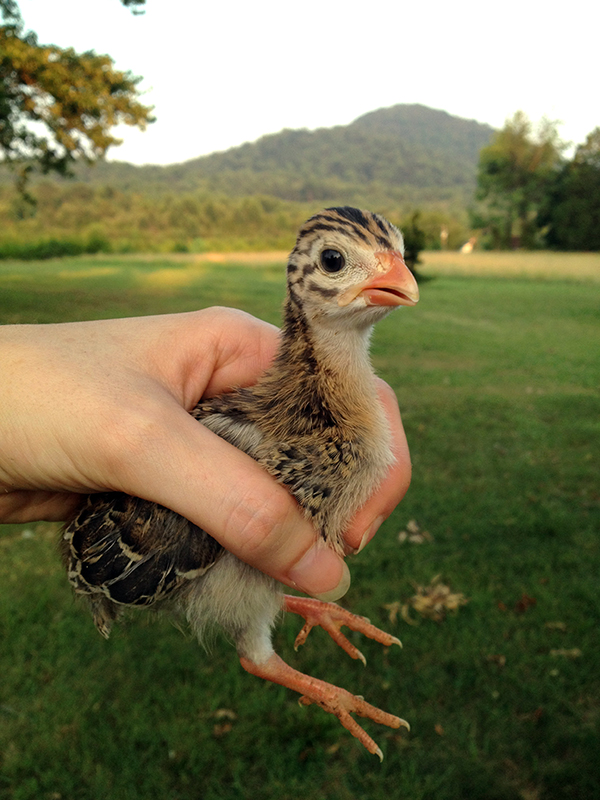
I got to watch the hatch and meet the still-damp keets, and it was one of the neatest days of my life. But this year, Iris has chosen to not do it again. Being trapped in a small cage with nine flighty, frantic, velociraptor-looking guinea keets was probably enough for her to sign off on motherhood forever. Not that I blame her—check out how those ravenous minidinosaurs are eying up their adopted mother’s toes while Iris pleads with her eyes for a Calgon moment.
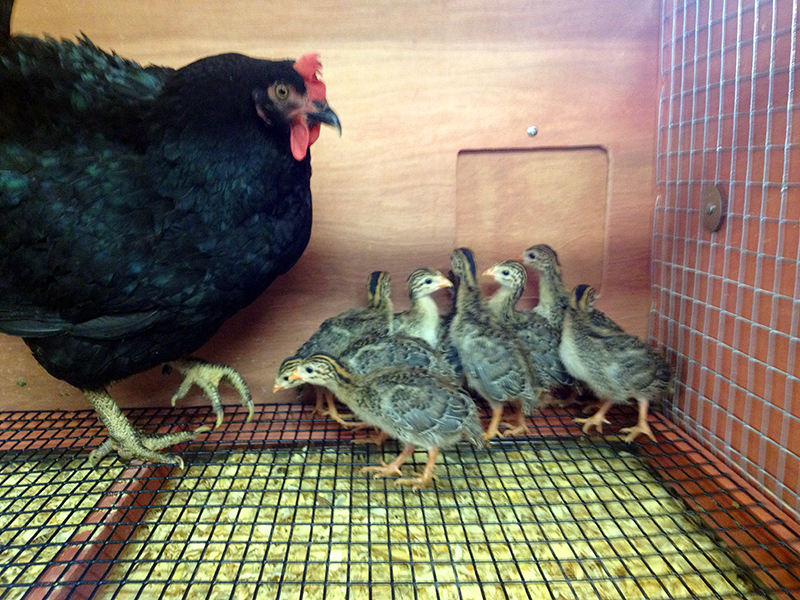
The most time-tested way to induce broodiness in a hen is to let eggs accumulate in the nest box. When the hen feels a growing clutch beneath her, some hormone switches in her brain that tells her to buckle down and brood. She will remain on the nest, barely eating and drinking, and will often pull feathers out of her breast so that she can keep the eggs tucked right next to her bare skin.
For weeks now I’ve been letting eggs accumulate, rotating out the older ones after a day or two in order to keep some in the fridge. I also placed the infamous glass eggs in the nests to trick the hens in to thinking there were always eggs waiting for a mother. And finally, it started to look like a few of then hens were beginning to feel broody.
Oregano, my beautiful barred olive egger, was the first to show any sort of devotion. After she’d been on the nest about a week, I fixed up a broody coop in the garage and built her a cardboard brood nest. It’s best to have a hen incubate eggs and raise chicks in a quiet, private place away from the bustle of the main coop, where flock mates may see new babies as tasty hors d’oeuvres. I was waiting for nightfall to move her to her new home when one of my Black Copper Marans saw the nest was exposed and jumped up to sit on the eggs.
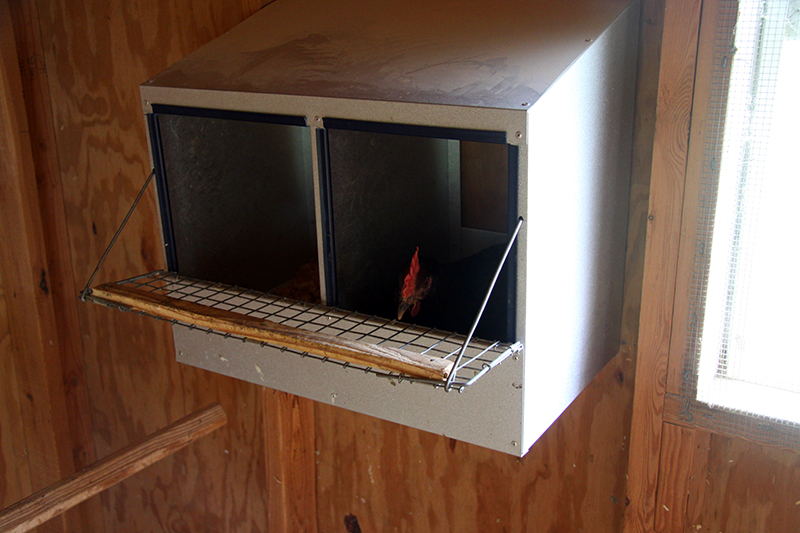
After dark, when I went to collect Oregano, the Black Copper Marans was still sitting tight on the eggs. One look and I got her message: She wanted a clutch of her own.
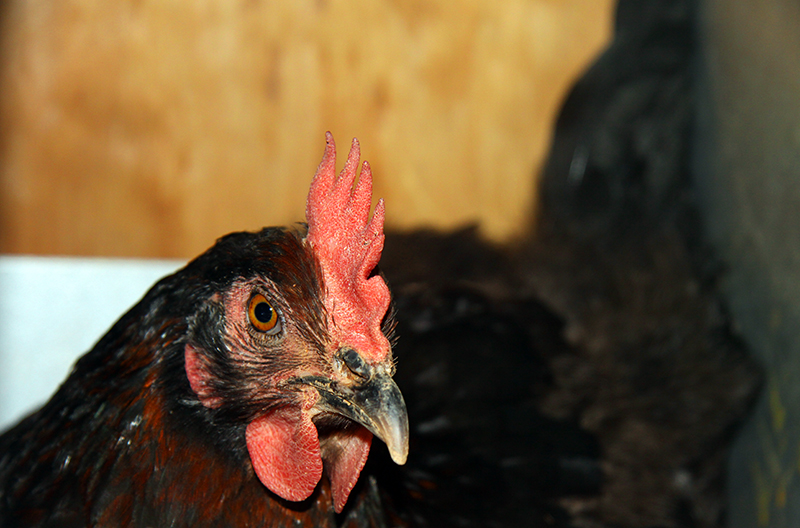
Oregano had assumed a broody position in the adjoining nest box. So I grabbed her and moved her and the eggs into the garage coop.

Oregano accepted her new nest and has stayed on it since Friday.
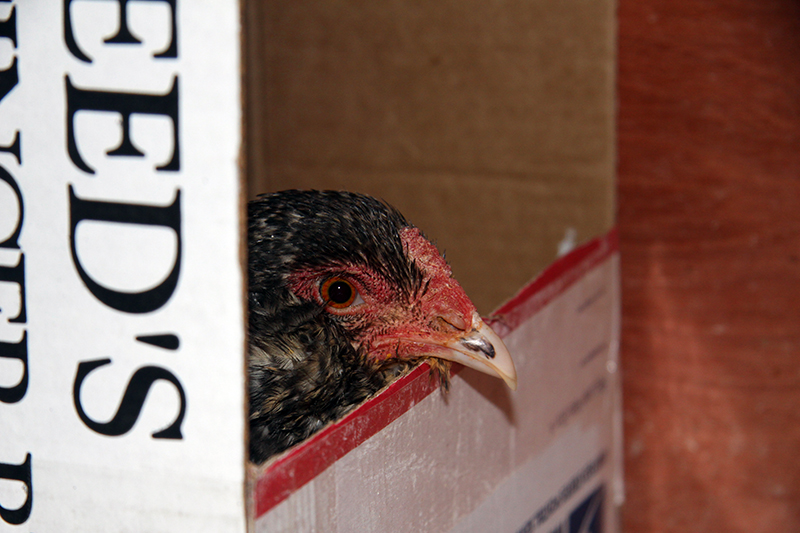
But the Black Copper Marans was still sitting on the glass eggs. And so I fixed up a second broody coop in the garage, built another cardboard next box, and last night moved her into a brood cage next to Oregano. So now I have two broody hens.
I have been saving out eggs for a week or so now, and when I get numbers I am satisfied with I will remove the glass and sacrificial eggs from under the hens and replace them with these fresh eggs. That way all embryos will start to develop at once, and all chicks will hatch at the same time. It’s a bit sad as the eggs are developing under Oregano, but their job really is to just “hold” the hen in a broody mindset until the more valuable eggs are introduced.
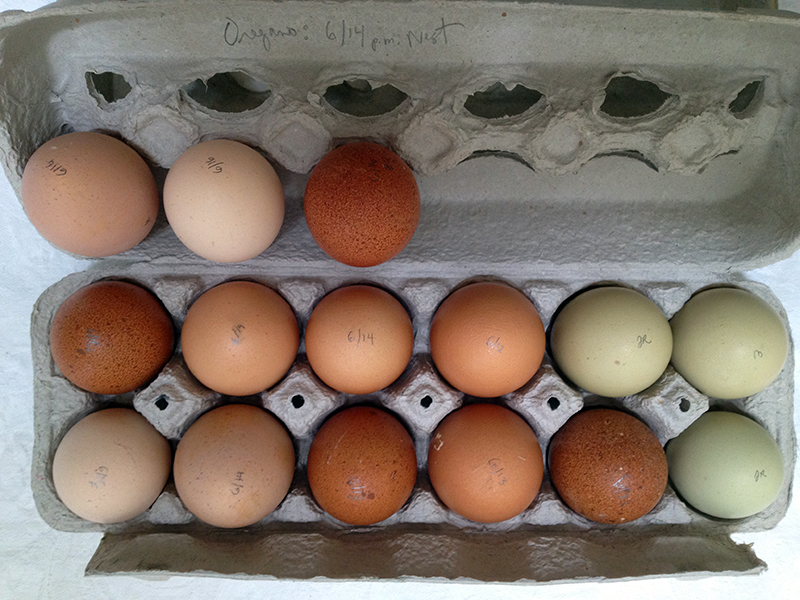
I wasn’t really planning on trying to raise two clutches, but at the end of the day it’s not such a bad thing. It means I can hatch more eggs, which is good as there is no way of knowing what the fertility rate is amongst my hens’ eggs. And, if one of the hens begins incubating and gives up, I could move the most valuable eggs to the other hen and have her take over. Thus, I am waiting until the same night to give both hens their eggs, and then we will see what happens! There is still a lot that can go wrong in the 21 days it takes to cook a chick, but I am having fun working with my broodies. If you’d like to know more, allow me to refer you to this excellent article by my favorite author on all things chicken, Harvey Ussery: Working with Broody Hens.
*A quick digression on chicken breeds and egg color: I have the right set-up to produce olive eggers, which, as their name suggests, lay olive colored eggs. To make a nice olive egger, you need a dark brown egg-laying breed (such as Black Copper Marans) mixed with a blue egg laying breed (Wheaten Ameraucana—my rooster). My Black Copper Marans don’t lay very dark eggs and I have no idea what sort of blue egg genetics my rooster carries, so I don’t suspect I will break any records with any pullets I hatch from that combination. But at the very least, I should end up with some sort of green egg, which is plenty exciting to me.
Now here is where it gets interesting. I have three eggs saved out from Oregano, my barred olive egger (the green eggs in the photo above). She does lay a very nice olive-colored egg, when she lays. By crossing her with Calabrese, and his blue egg genes, I may end up with a pullet that lays a really green egg, as opposed to an olive egg. But who knows, really? I have read about chicken genetics until I fell over from confusion and still am not sure what will happen. Mostly because I know nothing about the genetics of the birds I am starting with, other than their supposed breeds and what color eggs the hens lay now. And there’s always the possibility that I will hatch 100% cockerels and then the whole experiment is good for nothing but the freezer. And even if I do hatch pullets, it will be another year until they lay and who knows if I will even be in to chickens then!
February 5th, 2013 §
One upside of attending to my Lavender Orpington’s wound on Sunday was that I discovered she had lice. And when I snagged Oregano, my barred olive egger, for inspection I saw that she too had a few creepy crawlies. It was time for an intervention.
With a healthy flock, regular dust bathing will keep most parasites at bay. But in winter, with its frozen or muddy ground, the birds aren’t able to dust bathe as much as in the warmer seasons. This gives lice a chance to populate the birds. If unchecked, these blood-sucking parasites will deplete a bird to the point where it dies.
Thankfully my flock was no where near that stage. Yet, after spending a night researching various treatments I decided to go straight for the chemical intervention and not waste my time with more “natural” or “organic” methods. I really wanted to nip this infestation in the bud, particularly as it’s still winter and the birds need all the energy they produce just to keep warm and regrow the feathers they’ve lost. And, in another few weeks (if I can get Iris to go broody again) I’d like to try hatching some eggs, which means all my birds should be as healthy as possible and louse-free to avoid passing the bugs on to more-vulnerable chicks.
So I picked up a can of poultry dust, which is a permethrin-based formulation that you may have used for insects in your vegetable garden. I assembled my tools:

I also suited up in latex gloves and a dust mask. Well, the gloves were a joke because it took just one kick of a captured chicken to shred them. I went through five pairs through this process and still ended up covered in dust. If you’re concerned about skin contact, I’d suggest heavier gloves for this job. And, really, with all the flapping and wind I ended up covered with this dust so if you are truly concerned it may not be the treatment for you to use.
Cora, the Wheaten Ameraucana hen, was the first I caught in the coop. Following the advice of a YouTube video, I flipped her on her back. This seemed to calm her enough that I could powder under her wings, a favorite parasite hiding spot. I held her upside down to work the powder in to the feathers under her vent, which is where I saw the lice in all my birds.
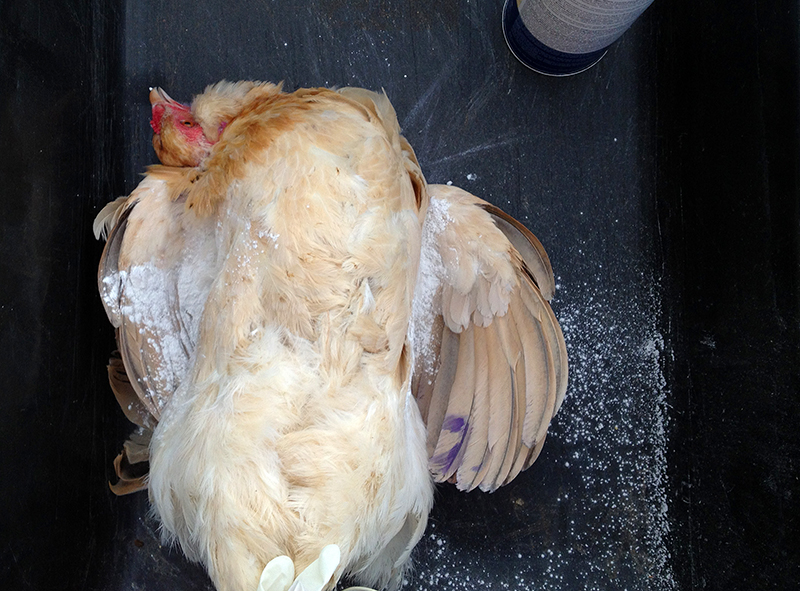
Lilac was up next.
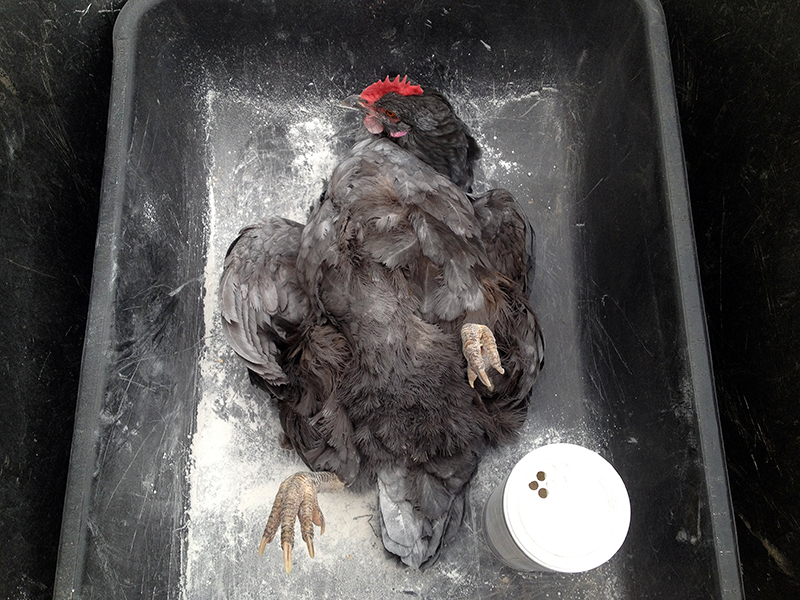
And so on through the flock. I left the injured Lavender until last so I could inspect her wound. It was open and bleeding, which I prefer to closed and infected, and seemed a tiny bit smaller than on Sunday.
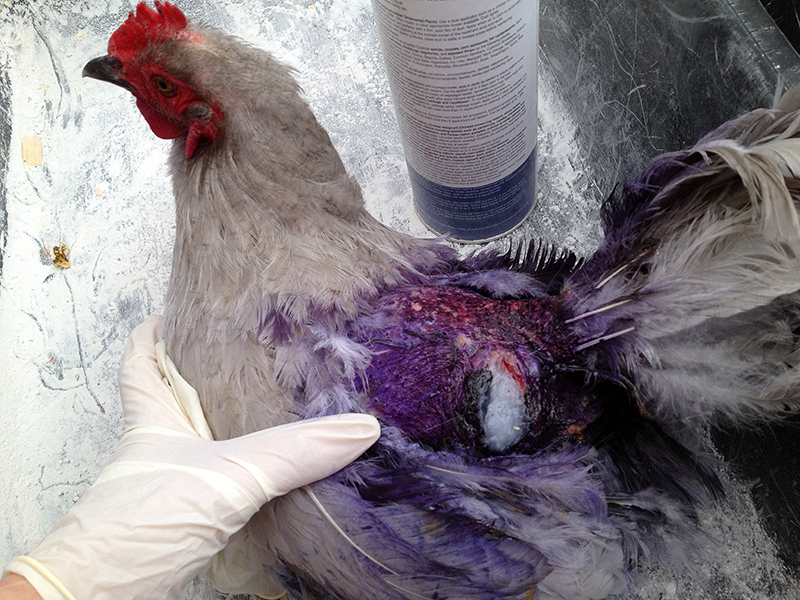
I packed it full of neosporin before dusting her.
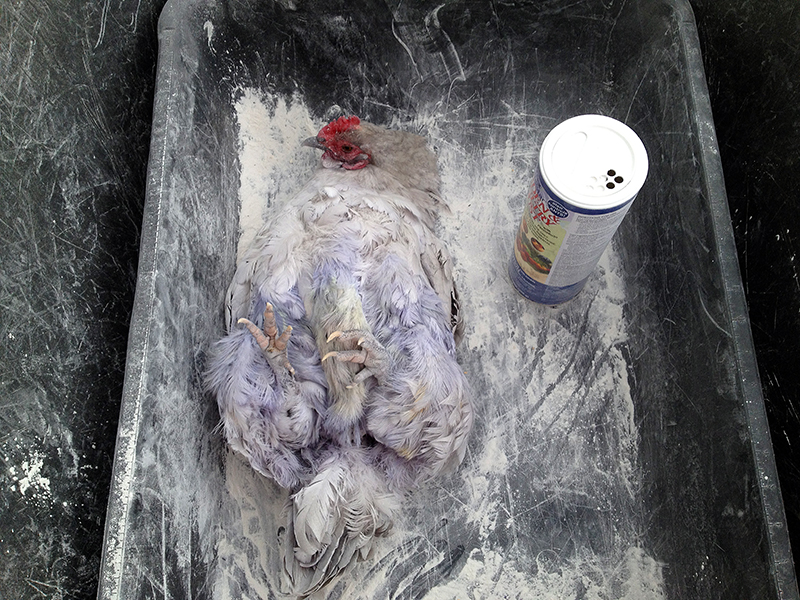
Now that’s a Lavender Orpington!
With the flock dusted, I did some housekeeping in the coop. I sprinkled food-grade diatomaceous earth in the nest boxes, in the chicken food, and filled a litter box with the stuff for dust-bathing in the coop. The diatomaceous earth, which is actually decomposed hard-shelled algae, acts in a mechanical manner (as opposed to chemical) on insects by slicing open their soft bodies, killing them.
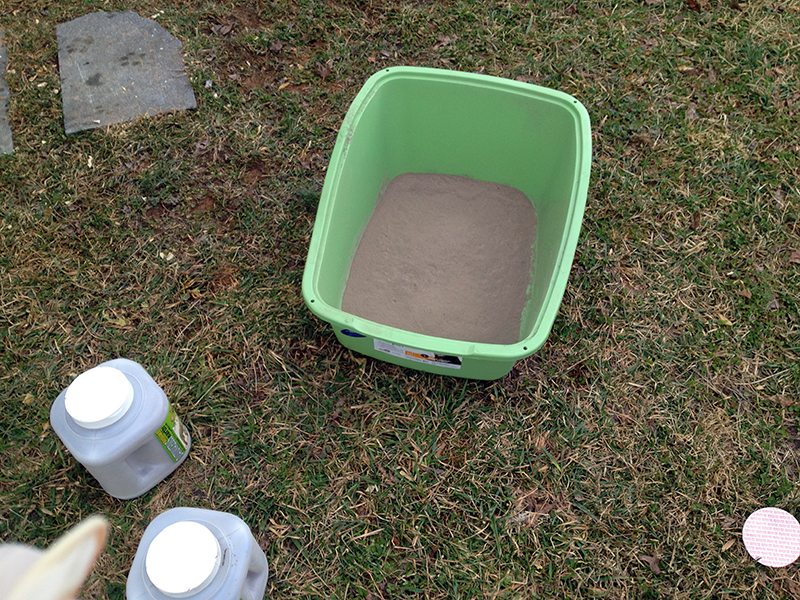
And with that the delousing procedure was complete. Now I get to look forward to ten days from now, when I repeat the powdering to kill any nits that will have hatched since today. Fun times!
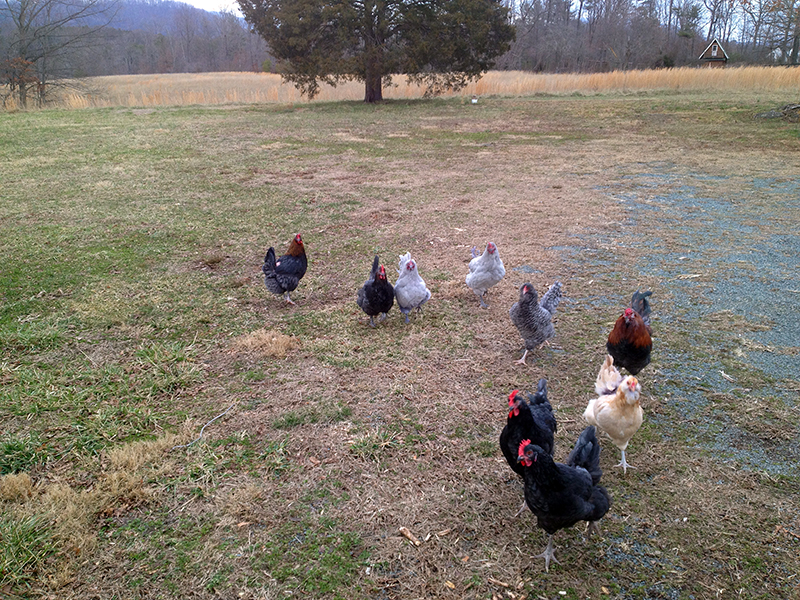
February 3rd, 2013 §
If you are sickened by chicken wound pictures or first aid, this would be the post to skip.
This morning as I let the chickens out to range, I grabbed my smaller Lavender Orpington hen as she came out of the coop. I’d knew she had a wound for at least a couple of months, and I’d been watching it. I suspect that without feathers to protect her back, courtesy of my feather-picking hen, my rooster had sliced the Lavender’s back with his claws when he mounted her. What had been a small black hole was now a wound the size of a golf ball, hidden behind her wing.
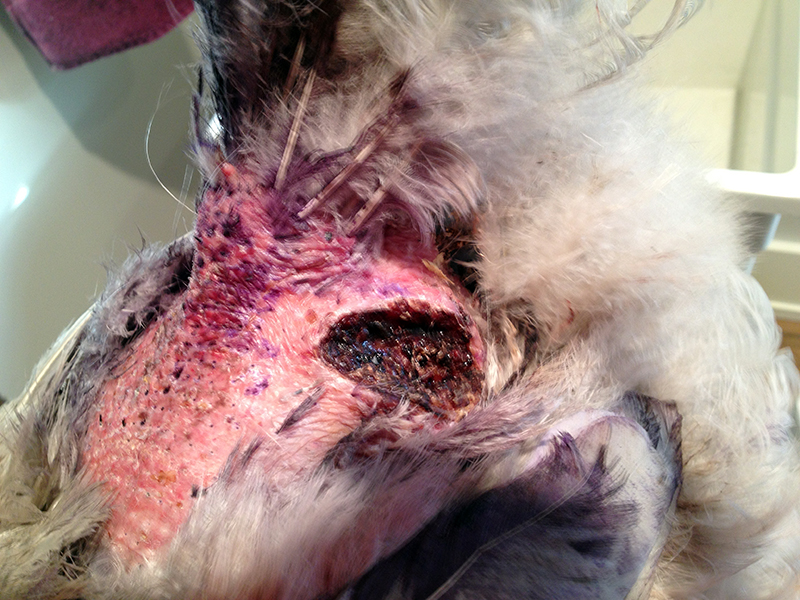
Today, for the first time, the wound smelled bad. And when I flipped the hen over, I found a messy bottom and some sort of infestation in the fluffy feathers under her vent.
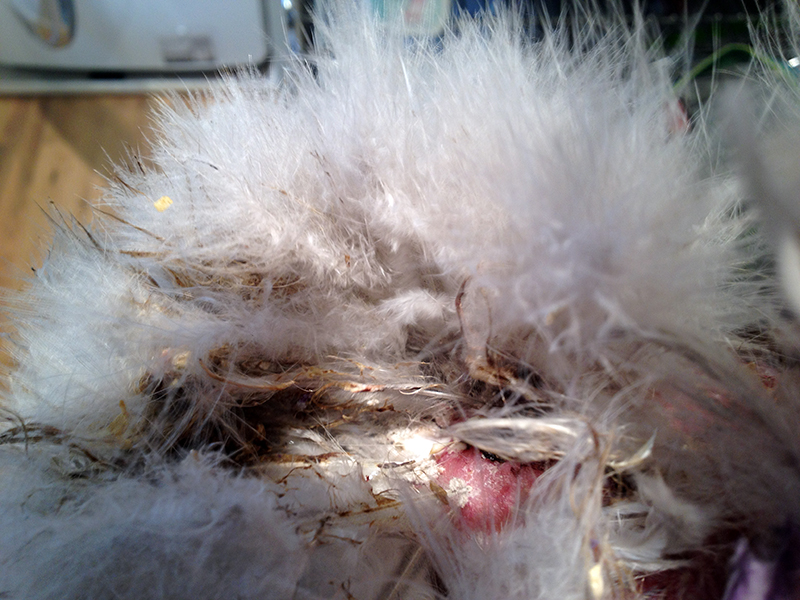
With her missing back feathers, purple Blu-Kote stains, a huge necrotic wound, and some sort of insect problem, this chick was a mess.
The evidence for culling her mounted as I considered her performance. This hen wasn’t a great layer, always depositing smallish eggs on the coop floor where they usually grew dirty enough that I fed them right to my dog. I’d made up my mind I didn’t want to continue to keep Lavender Orpingtons because I found their super-fluffy butt feathers to be always collecting poop and debris. And if she hadn’t managed to heal her back wound, did I really want to continue her genetics in my barnyard mix?
But what started as a snowy day had turned sunny, so I returned the hen to the flock for one last day of free ranging before I did the deed. And in the ensuing hours I thought about how I would. I had settled on beheading by branch lopper when I went out around noon to give the chickens the goodies in the compost bucket. When they saw me they all came running, including Dead Hen Walking. When I shook the compost around the garden, she was just as active as the other birds. I stood watching her for a long time, and when my feet finally grew too cold to stay outside any longer I had decided to put some effort into healing this bird.
With eight laying hens, two of which aren’t very stellar in their production rate, this Lavender’s dirty eggs represented a big percentage of my flock’s output. And I’d recently decided to free range my birds as much as possible, and thus some of her value lies in her insect control ability and manure production. Plus, I am fully expecting some predator loss during ranging. After considering the time and expense and food and care that I’ve put in to this bird since I got her in June, to get her grown and laying, it seemed foolish to cull her if she was still up and about and acting fine—even though the last thing I wanted to do was nurse another chicken.
But nurse her I did. I caught her and brought her into the surgery, my laundry room sink. I filled her back wound with peroxide while I soaked her dirty bum feathers in warm water. I scrubbed her clean with dog shampoo and then used needle-nosed pliers to remove the feathers that were caked with the eggs sacs of what I later found out were chicken lice. Underneath her plucked feathers she looked very much like the start of a supermarket dinner. When her back wound had softened I scrubbed it out with a disinfected toothbrush, loosening the blackened tissue and rinsing it down the drain. Then I alternated rinsing peroxide and providone iodine in the wound.
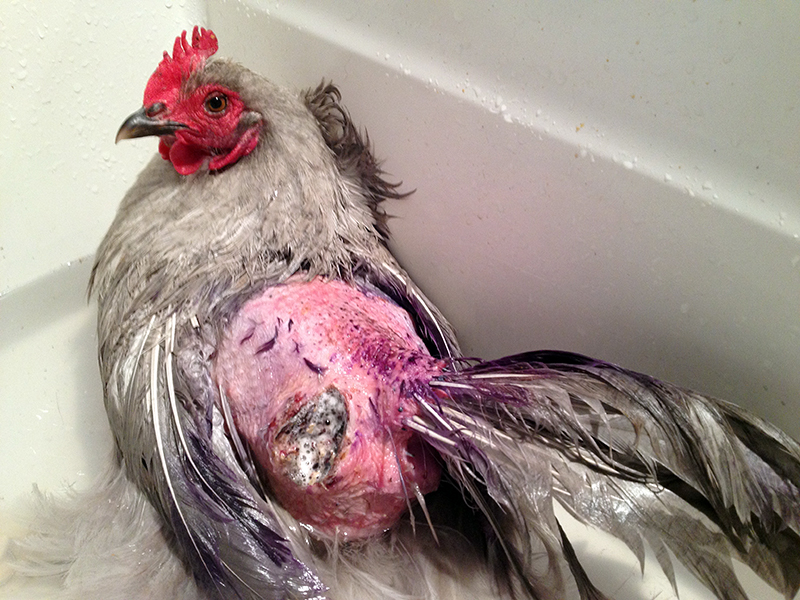
And through what must have been a horribly painful event, this blessed little hen put up nary a struggle. I’ve found my Lavender Orpingtons to be the sweetest, slowest, and most docile of all the breeds I keep, and her demeanor definitely showed through this treatment. She even seemed to enjoy the warm water soak.
When I had her cleaned up as best as I could, I got the hair dryer and blew her dry. I didn’t want her to get chilled when I returned her to the coop, and she bore this treatment with good graces that none of my other pets possess.
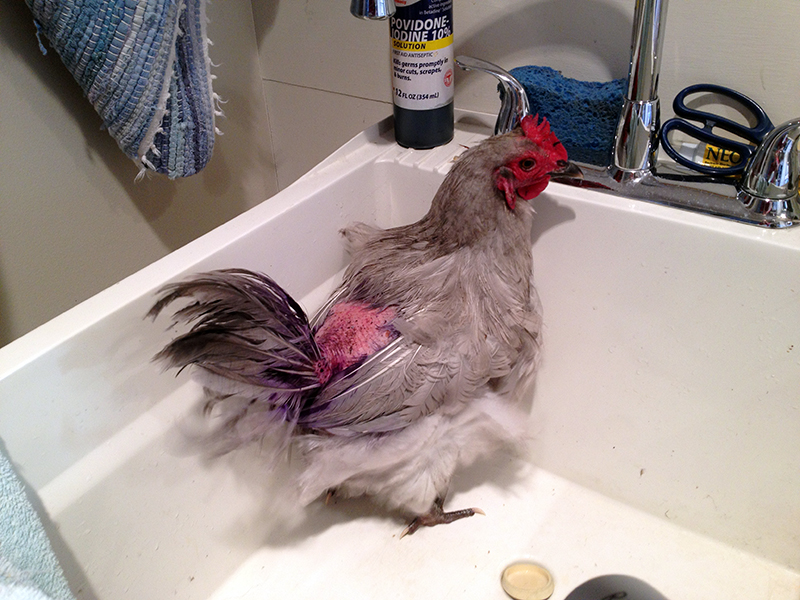
I worked on her until she began to smell of rotisserie, and then squirted even more iodine into her wound. Then I wrapped her in a towel and took her outside.

There she got a good spray of Blu-Kote to discourage her flock mates from pecking her bleeding, reddened skin. Then I released her into the coop. And within one second my rooster jumped on her back to mate. That kind of pissed me off, so I knocked him away and left them to their lives.
I don’t know if I will be able to get this hen’s back wound to heal, but I will keep trying. If Cora taught me anything it’s that chickens are incredibly resilient. Tomorrow I am going to get some diatomaceous earth and create a dusting box for the birds. Apparently chicken lice populations bloom in winter when the birds can’t dust bathe because of frozen or muddy ground. So I will start as conservatively as possible to treat the lice, keep an eye on the Lavender hen, continue allowing the birds out to free range as much as possible, and dream of spring.
November 26th, 2012 §
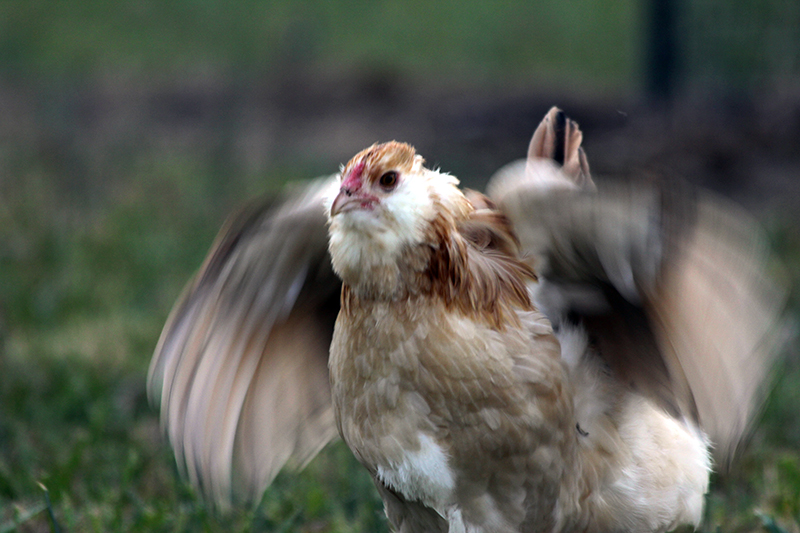
On November 8, Cora laid her first perfect blue egg. This was a discovery of pure joy as Cora—my only Wheaten Ameraucana pullet— survived a vicious attack in her young life and walked so close to death for several months as her scalped head healed.
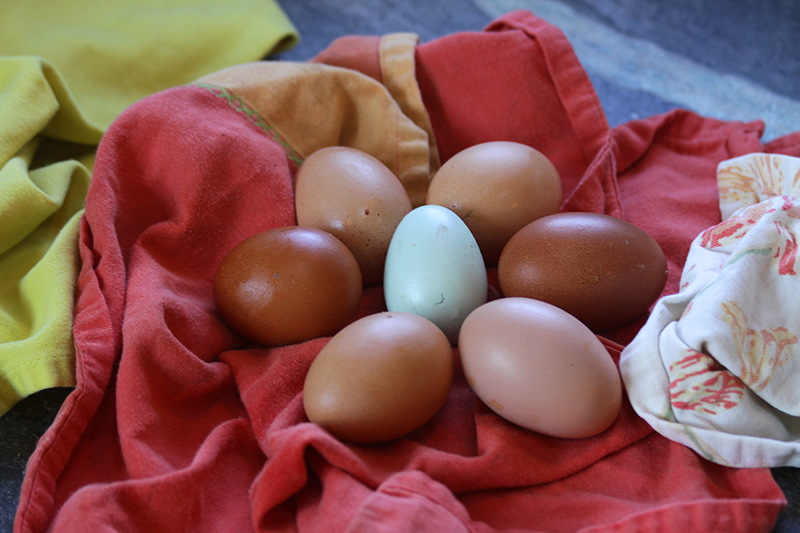
The Black Copper Marans have also started laying (darkest brown eggs above), as well as the Lavender Orpingtons (light-toned eggs above). Lilac and Iris still seem to be keeping up in their second year of laying. The light on a timer set to turn on at 5:00 a.m. seems to be doing the trick to foil the low-daylight hour laying slowdown. My record has been seven eggs in one day, which of a flock of eight hens is a pretty good return. I am not sure that my “barred olive egger” Oregano has laid yet—if she has, she’s not an olive egger!
One of the best parts of my day is picking up the eggs. It’s this pleasure that exists to offset the pain of discovering and nursing bleeding mostly dead birds, managing flock integration, mucking out the coop, and all the other rough aspects of being mother hen.
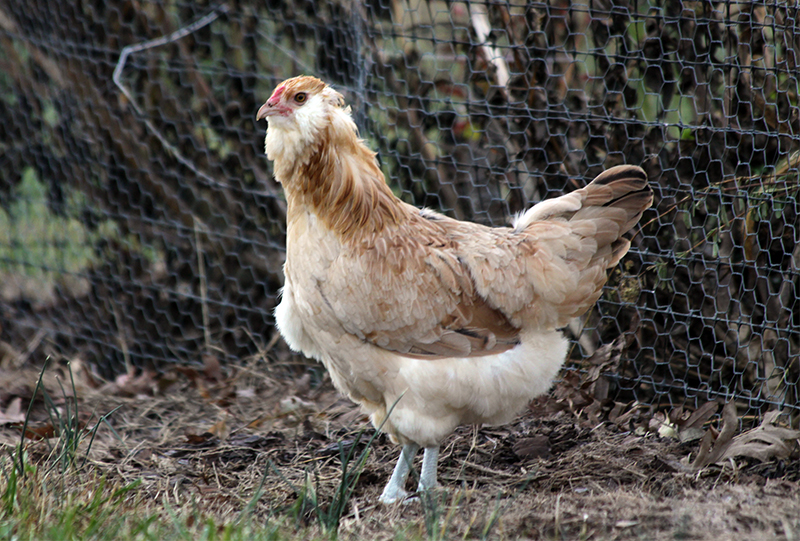
Recovered, and now productive, Cora, with only a slightly mussed feather pattern about her beautiful head to belie her hard young life.
October 8th, 2012 §
One of my lavender orpington pullets came online today and laid her first egg. That extra light in the morning must be working. Here’s her egg on the right, next to Iris’s daily contribution. Not bad for a pullet egg—and she even managed to get it in the nest box! I am excited to see the other young hens start to contribute to the daily egg count.
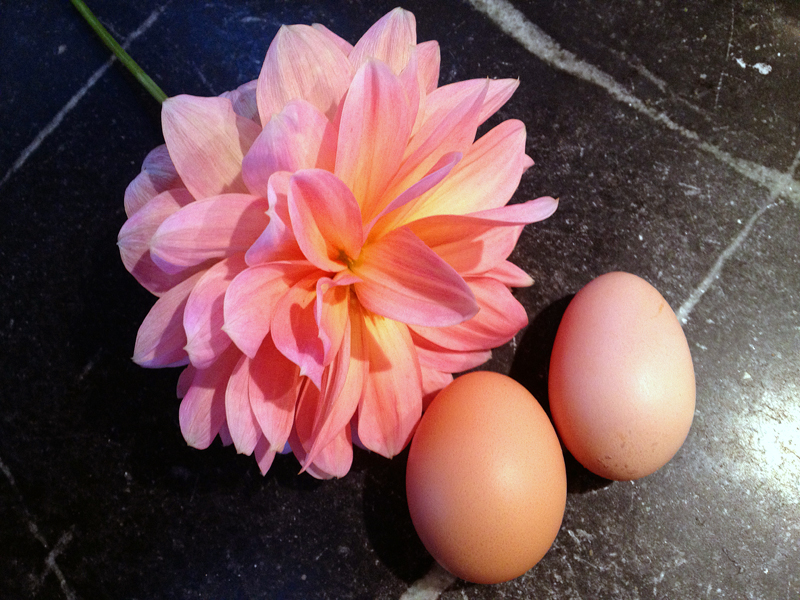
In other news, I ran out to the garage this evening—in my slippers—to retrieve something from the car. On my way out I looked down and saw this:

Looks like I’d smashed this black widow on the floor! That’s pretty close for comfort…weird too as last Friday night I dreamed I was bitten by something on my foot, I saw two marks and dream-assumed it was a snake bite but maybe it was a spider warning!
If you had any doubt, I flipped this lady over to show her identifying red hourglass. She was pretty good-sized!

Tonight’s our first taste of the coming winter. It’s in the low 40s and grey and rainy. My house is about 63 degrees without the central heat yet on and I am eying the woodstove with longing. Too many other things to do tonight to get involved with the first fire of the season, so that will have to wait and in the meantime I am in triple layers of wool and sheepskin. Plus, it’s supposed to return to the 70s later this week!
September 29th, 2012 §
I got up this morning and, all inspired by the things I learned from Patricia Foreman at the Mother Earth News Fair, decided to turn my chickens loose in my garden. There’s not too much in it now other than flowers and some last-ditch attempts at peas, beans and greens, and I figured that if the chickens took a shining to any of those it’d be no big loss. What I’m really after is pest control.
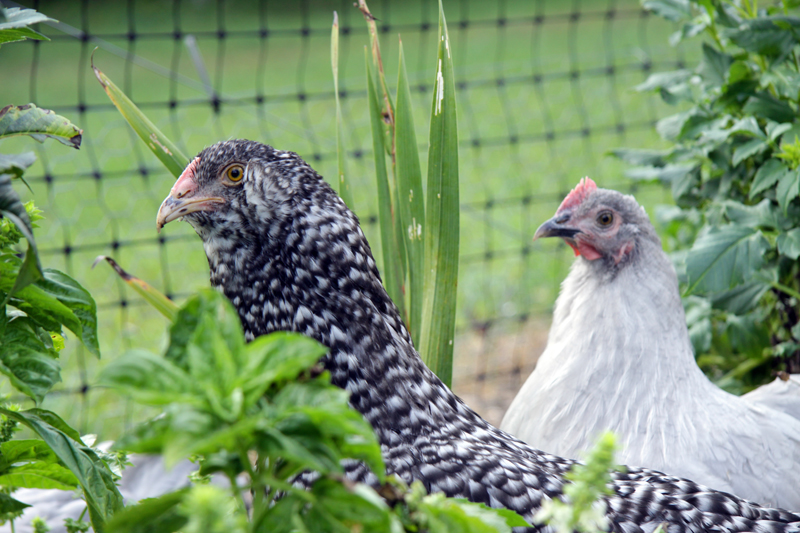
I caught each bird in the coop and plopped them in the garden, which when closed up in a fairly predator-proof arrangement. I wasn’t too worried about hawks as the dahlias and zinnias were tall and thick enough to provide good cover. Plus, I have a farm dog who took it upon himself to add “vigilantly defends against threats from the sky” to his long list of qualifications.
I checked on the birds throughout the day while I did one of my least-favorite farm chores, mulching around my trees. I wanted to make sure Lilac, who until now had been confined in a dog crate in the coop because she showed murderous tendencies toward Cora, was playing nicely. Everyone was fine all day.

Around five tonight I realized I’d better figure out how to get the birds back in their coop. Now, seven of my nine birds had never ventured further than their little redneck chicken run, and I couldn’t expect to just open the garden door and have them know how to find home. And chasing—and most likely losing—birds that had no ability to figure out how to get to bed before dark induced cringe-worth flashbacks to all the drama suffered with my guineas. I needed another plan.
So I did what any scrappy homesteader would do and looked around for something to repurpose for my needs. I found what I was looking for in a roll of netting that’s usually used to protect bushes from browsing deer. It’s much finer, and therefore easier to handle, than the heavy-duty plastic deer fencing I used around the garden and to make the chicken run. Plus, in addition to an almost new roll, I even had some already used netting balled up in a corner of the garage. I’d stuffed it there after I’d found it in the wellhouse, where it served as a death trap to what was by now a well-dessicated black snake. It’s been long enough that my memory of cutting that rotten snake out of the netting has faded, so I grabbed that piece as well.
A few clothespins later and I’d fashioned a corridor from the garden door into the chicken run. I opened the netting that serves as my garden door and within a second Cora and Calabrese strutted home.
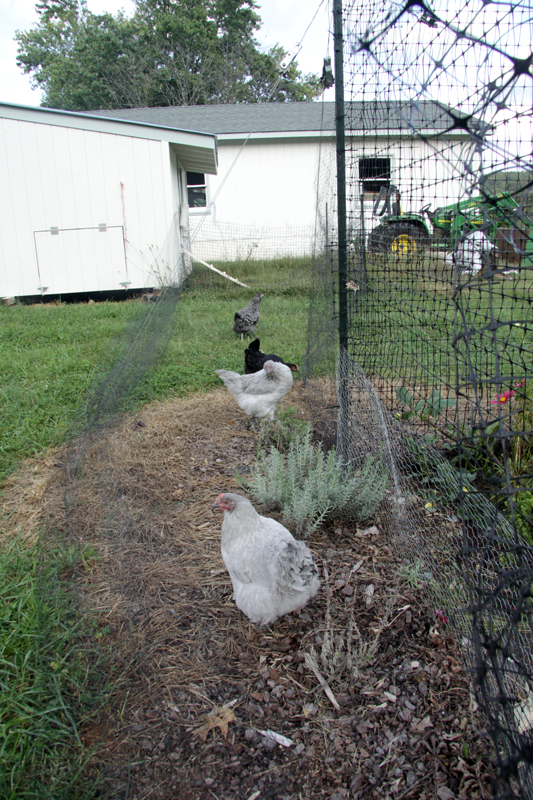
The rest of the birds took a bit of convincing, with Iris and Lilac, who are used to freeranging (and begging for scratch feed) bringing up the rear.
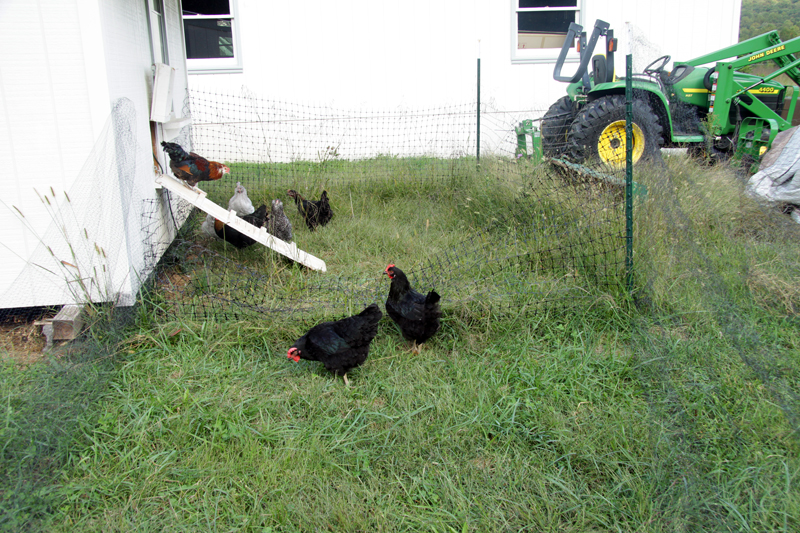
But they too joined the flock in the run, and from there they jumped back in their house to gorge on chicken feed like they hadn’t just spent eight hours enjoying all the wild delicacies of a late-summer garden.
I’ve left left Lilac loose with the flock instead of returning her to her punitive crate. I hope that she decides to be a get-along gal, or she may need to find herself another home. It will be another nerve-wracking morning when I open the coop tomorrow, unsure of what I may find. Let’s hope it’s nine nonbleeding chickens.
In other chicken news, I put a timer on the coop light this morning to artificially extend the hens’ day, thus inducing them to continue to lay through the winter. When the length of daylight slips below about fourteen hours, most hens will stop laying. Last year I didn’t use a light, and Lilac and Iris took a break from laying during the darkest part of the year.
The jury is out on whether it’s “good” or “bad” to have hens lay throughout the winter, with some camps claiming that the hens need the winter to rest even though the original chickens lived near the equator, where daylight hours don’t expand and contract with the seasons they way they do in Virginia. Several variables factored in to my decision, the first being that last winter when my hens weren’t laying I was buying eggs from Joel Salatin’s operation, Polyface Farm. If he was doing something to keep his hens laying in winter, why wasn’t I? Somebody’s hen, somewhere, will have to work through the winter so it might as well be mine. Second, the cost of feed has risen to more than $15 per 50 lb. bag. With each hen eating about a quarter pound of feed a day (thus my experiment to have the chickens forage for a larger percent of their diet), it doesn’t make economic sense to not be getting something out of the bird. As much as I love my chickens, they are not freeloading pets. And even my house pets, a dog and a cat, work for their food in myriad ways. Finally, I got a late start with chicks this year and have six hens—two lavender orpingtons, two black copper marans, a barred olive egger, and a wheaten ameraucana, who have yet to begin laying. I don’t really want to wait until next spring to see the rainbow of eggs they’re expected to produce, so I hope that extra light in the winter will get them in to production before next spring. That light’s coming on in the coop starting at 5:00 a.m. tomorrow, so we’ll see what happens!





























